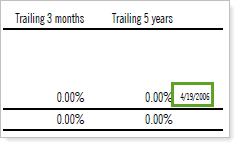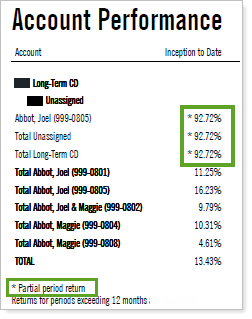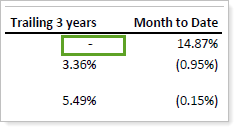Contents
|
Mark The Date Period Title If All Returns For The Date Period Are Partial Returns |
How Partial Returns Works
| Applies to: | |||
|---|---|---|---|
| Dynamic | Client Portal |
✔ PDF Report Builder |
|
When calculating returns on the report, there are times when the calculated return is not based on the entire period shown on the report. For example, the account inception date was in the middle of the return period reported, or when reporting on securities, the security was purchased within the return time period. In these scenarios, many of you wanted a way to identify those accounts and securities.
This setting helps add context to the story, answering "How long was the security held and how much impact is it having on the overall return?" by allowing you to identify the partial period return with a footnote, double dashes ( -- ), not identify them, or include the actual start date for each partial return. It works in conjunction with Show Actual Return Dates.
By default, Tamarac Reporting uses the following indicators for returns in these circumstances:
| Display | What it means |
|---|---|
| n/a |
This applies only to performance returns. |
| - |
This takes precedence over n/a. |
| 0 |
|
You might choose to use Partial Returns depending on amount of space available in your PDF columns, or whether or not you think it would be beneficial for your clients to see this detail.
In Dynamic Reports
This setting is not available for dynamic reports.
In PDF Reports

-
To report partial returns without marking them in any way, choose Do not mark.
-
To mark returns with the actual start date, choose Do not mark or Mark with footnote and select Show actual return dates.

Be aware that:
-
The Summary by Category report does not show actual return dates.
-
Selecting Show actual return dates adds a column to the PDF report. Be aware that this could cause rendering errors, depending on the other report settings.
-
-
To mark partial returns with a footnote, choose Mark with footnote. The footnote is added at the end of the section, not at the bottom of each page.

-
To not report partial returns, choose Mark with dash. This replaces the partial return with a dash ( - ). This display option can also be combined with showing the actual return start date of the account or the security.

Mark The Date Period Title If All Returns For The Date Period Are Partial Returns
This setting allows you to indicate where you'd like partial returns to be marked: on the date period for the row or on the return itself.

For more information, see Mark The Date Period Title If All Returns For The Date Period Are Partial Returns.
In Report Builder
Functionality is the same in the Report Builder as in PDF report templates.

Reports With This Setting
Performance ReportsRelated Settings
For more information about calculating performance, see Learn More About Calculations.
The following setting interacts with this option:
